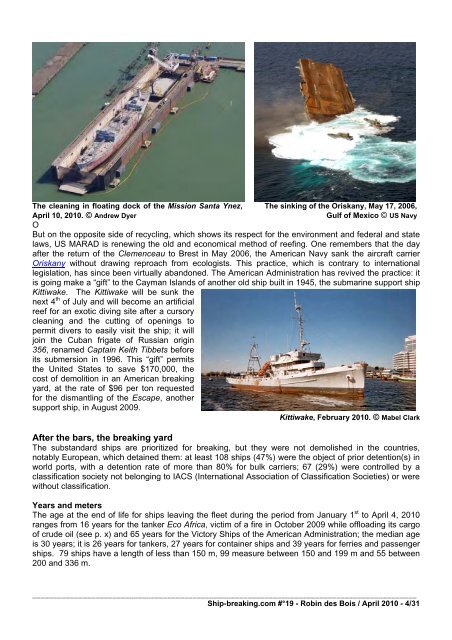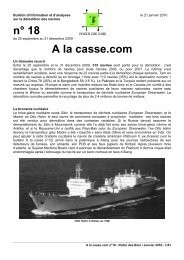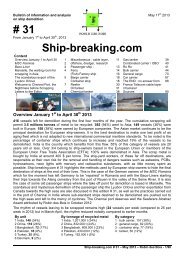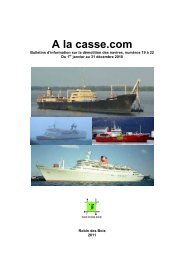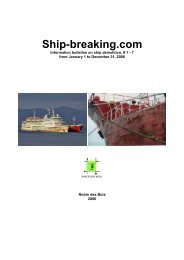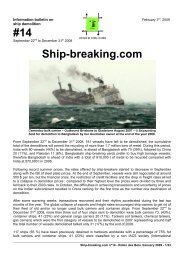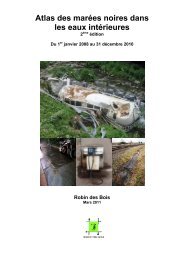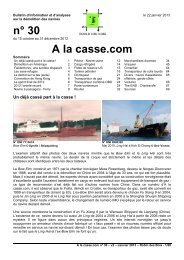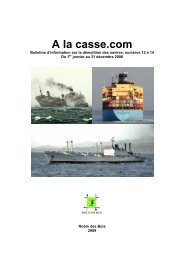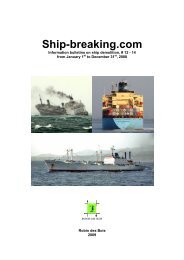Ship-breaking.com - Robin des Bois
Ship-breaking.com - Robin des Bois
Ship-breaking.com - Robin des Bois
Create successful ePaper yourself
Turn your PDF publications into a flip-book with our unique Google optimized e-Paper software.
The cleaning in floating dock of the Mission Santa Ynez, The sinking of the Oriskany, May 17, 2006,<br />
April 10, 2010. © Andrew Dyer<br />
Gulf of Mexico © US Navy<br />
O<br />
But on the opposite side of recycling, which shows its respect for the environment and federal and state<br />
laws, US MARAD is renewing the old and economical method of reefing. One remembers that the day<br />
after the return of the Clemenceau to Brest in May 2006, the American Navy sank the aircraft carrier<br />
Oriskany without drawing reproach from ecologists. This practice, which is contrary to international<br />
legislation, has since been virtually abandoned. The American Administration has revived the practice: it<br />
is going make a “gift” to the Cayman Islands of another old ship built in 1945, the submarine support ship<br />
Kittiwake. The Kittiwake will be sunk the<br />
next 4 th of July and will be<strong>com</strong>e an artificial<br />
reef for an exotic diving site after a cursory<br />
cleaning and the cutting of openings to<br />
permit divers to easily visit the ship; it will<br />
join the Cuban frigate of Russian origin<br />
356, renamed Captain Keith Tibbets before<br />
its submersion in 1996. This “gift” permits<br />
the United States to save $170,000, the<br />
cost of demolition in an American <strong>breaking</strong><br />
yard, at the rate of $96 per ton requested<br />
for the dismantling of the Escape, another<br />
support ship, in August 2009.<br />
Kittiwake, February 2010. © Mabel Clark<br />
After the bars, the <strong>breaking</strong> yard<br />
The substandard ships are prioritized for <strong>breaking</strong>, but they were not demolished in the countries,<br />
notably European, which detained them: at least 108 ships (47%) were the object of prior detention(s) in<br />
world ports, with a detention rate of more than 80% for bulk carriers; 67 (29%) were controlled by a<br />
classification society not belonging to IACS (International Association of Classification Societies) or were<br />
without classification.<br />
Years and meters<br />
The age at the end of life for ships leaving the fleet during the period from January 1 st to April 4, 2010<br />
ranges from 16 years for the tanker Eco Africa, victim of a fire in October 2009 while offloading its cargo<br />
of crude oil (see p. x) and 65 years for the Victory <strong>Ship</strong>s of the American Administration; the median age<br />
is 30 years; it is 26 years for tankers, 27 years for container ships and 39 years for ferries and passenger<br />
ships. 79 ships have a length of less than 150 m, 99 measure between 150 and 199 m and 55 between<br />
200 and 336 m.<br />
___________________________________________________________________________________________<br />
<strong>Ship</strong>-<strong>breaking</strong>.<strong>com</strong> #°19 - <strong>Robin</strong> <strong>des</strong> <strong>Bois</strong> / April 2010 - 4/31


